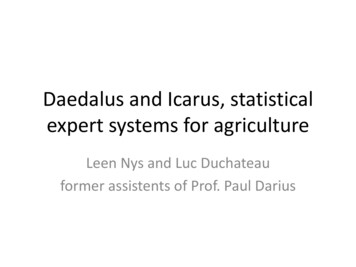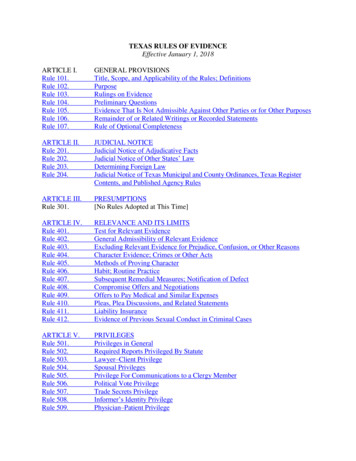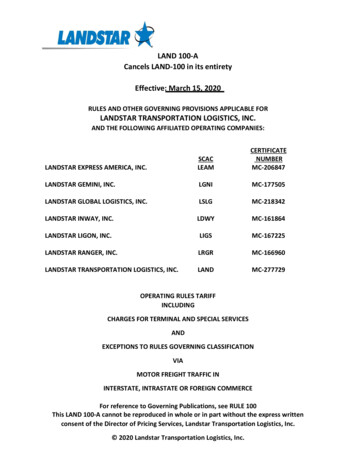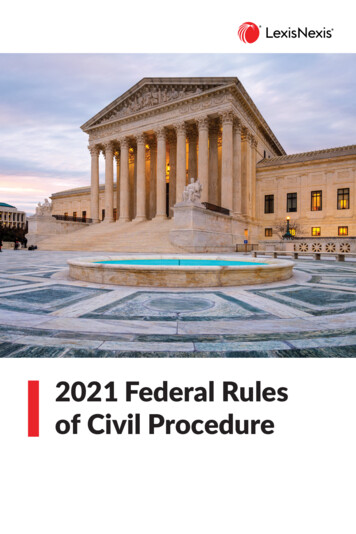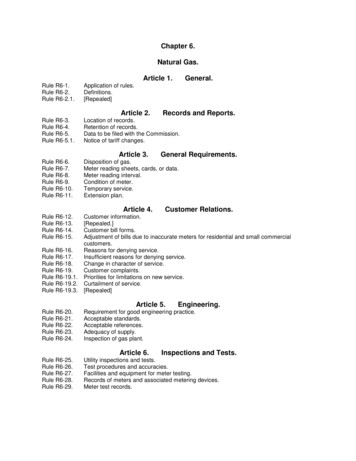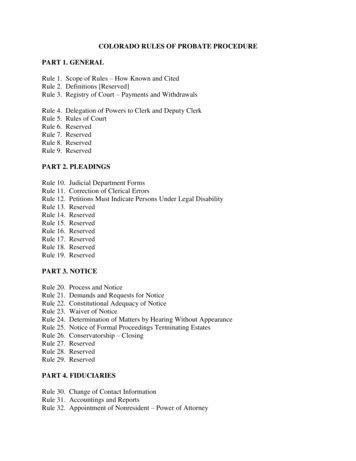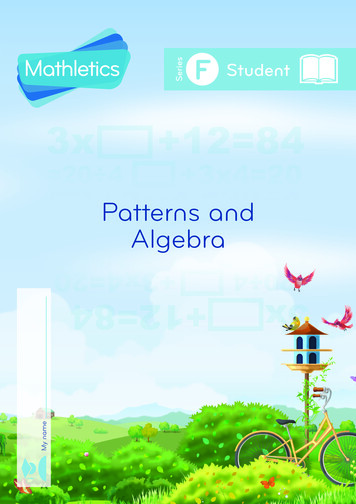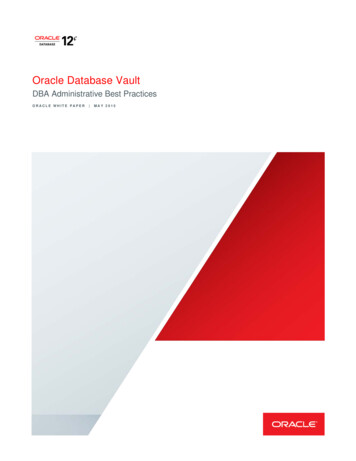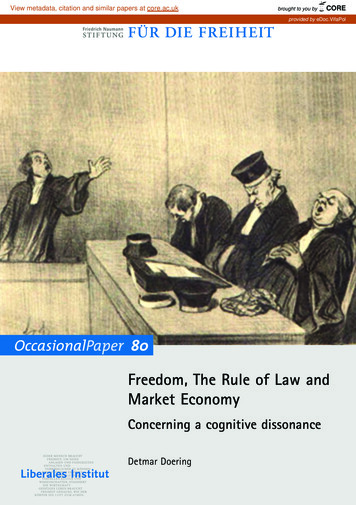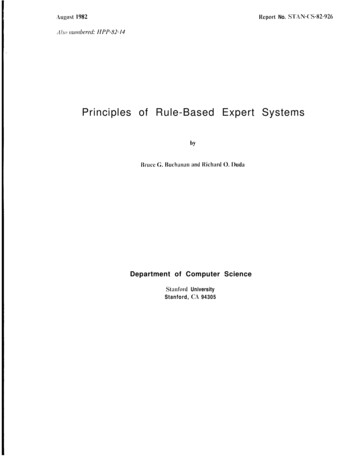
Transcription
Rqort No. STAN-C’S82-926Principles of Rule-Based Expert SystemsDepartment of Computer ScienceStauford UniversityStanford, CA 94305
.August 1982Heuristic Programming Project ’Report No. HPP-82-14also:FairchildTechnical Report No.626Principles of Rule-Based Expert SystemsBRUCE G. BUCHANANHEURISTIC PROGRAMMING PROJECTDEPARTMENT OF COMPUTER SCIENCESTANFORD UNIVERSITYRICHARD 0. DUDALABORATORY FOR ARTIFICIAL INTELLIGENCE RESEARCHFAIRCHILD CAMERA AND INS rRUMENT CORPORATIONPALO ALTO, CALIFORNIA.The Stanford University component of this research is funded inpart by ARPA contract # MDA903-80-C-0107, NIH contract # NIH RR 0078509,ONR contract # NO001 4-79-C-0302, and Schlumberger-Doll Research Laboratory.To appear in M. Yovits ted.) Advances in Computers, Vol.22,New York: Academic Press
3
iTable of Contents1 INTRODUCTION: WHAT IS AN EXPERT SYSTEM?1.1 Example: The MYCIN Program1.2 Key Components2 REPRESENTATION OF KNOWLEDGE2.1 Rule-Based Representation Frameworks2.1.1 Production Systems2.1.2 EMYCIN Viewed as a Production System2.2 Alternatives to Rule-Based Representation of Knowledge2.2.1 Frame-Based Representation Languages2.2.2 Logic-Based Representation Languages2.2.3 Generalized Languages2.3 Knowledge Representation Issues3 INFERENCE METHODS IN EXPERT SYSTEMS3.1 Logical and PlauSible Inference3.2 Control3.2.1 Data-Driven Control3.2.2 Goal-Driven Control3.2.3 Mixed Strategies3.3 Explicit Representation of Control Knowledge4 REASONING WITH UNCERTAINTY4.1 Plausible Inference4.2 Bayesian Probability Theory.4.2.1 Combining Rules4.2.2 Uncertain Evidence4.3 Certainty Theory4.3.1 Combining Evidence4.3.2 Uncertain Evidence4.4 Possibi1it.y Theory4.5 The Dempster/Shafer Theory of Evidence5 KEY CONCEPTS5.1 Classes of Problems for Expert Systems5.2 The Data5.3 The Expertise6 CONCLUSIONS7 324242426272828293031323536373840
3
1Principles Of Rule-Based Expert Systems .Bruce G. BuchananRichard 0. Duda1 INTRODUCTION: WHAT IS AN EXPERT SYSTEM?An expert system is a computer program that provides expert-level solutions to ‘important problems and is:heuristic -- i.e., it reasons with judgmental knowledge as well as with formal knowledge ofestablished theories;0 transparent -- i.e., it provides explanations of its line of reasoning and answers to queries about its.knowledge;l flexible -- i.e., it integrates new knowledge incrementally into its existing store of knowledge.‘.lThe key ideas have been developed within Artificial Intelligence (AI) over the last fifteen years, but in the lastfew years more and more applications of these ideas have been made. The purpose of this article is tofamiliarize readers with the architecture and construction of one important class of expert systems, called rulebased systems. In this overview, many programs and issues are necessarily omitted, but we attempt to provide aframework for understanding this advancing frontier of computer . science.Because computers are general symbol manipulating devices, the non-numeric and heuristic aspects of problemsolving can be encoded in computer programs as well as the mathematical and algorithmic aspects [Newe1176].Artificial Intelligence research has focused on just this point. Work on expert systems is, in one sense, theapplied side of AI, in which current techniques arc applied to problems to provide expert-level help on thoseproblems. However, there is more to building an expert system than straightforward application of AItechniques. In this early stage of dcvelopmcnt, each new application challenges the current stock of ideas, andmany applications force extensions and modifications.We focus on rule-based systems in this survey because they clearly demonstrate the state of the-art in buildingexpert systems and illustrate the main issues. In a rule-based system, much of the knowledge is represented asrules, that is, as conditional sentences relating statements of facts with one another. Modus ponens is the. primary rule of infercncc by which a system.adds new facts to a growing data base:1PWe use the term ‘expert system’ more restrictively than many authors. In doing so, WC distinguish expert systems from, among others,programs that perform well but cannot bc examined and programs that arc exarninablc but do not perform well and programs that solveproblems for which no special cxpcrtisc is required. For other recent rcvicws of the state of the art of expert systems, see [l3onnet81,Buchanan81, DavisKIa, Duda81, Fcigcnbaum79, I-Iayes-Roth78, Iafotcch81, Michie79, Michic80, Pinson81, Stefik82, Waterman781
.2IF B IS TRUEAND B IMPLIES C,THEN C IS TRUE.ORBB -- c-------CConceptually, the basic framework of a rule-based. system is simple; the variations needed to deal with thecomplexities of real-world problems make the framework interestingly more complex. For example, the ruleB-X is often interpreted to mean “B suggests C”, and strict deductive reasoning with rules gives way toplausible reasoning. Other methodologies are also mentioned and briefly discussed.In an expert system the fundamental assumption is “Knowledge is Power”. Specific knowledge of the task iscoupled with general problem solving knowledge to provide expert-level analyses of difficult situations. Forexample, MYCIN (described below) analyzes medical data about a patient with a severe infection,PROSPECTOR [Duda79] analyzes geological data to aid in mineral exploration, and PUFF [Kunz78] analyzesthe medical condition of a person with respiratory problems. In order to provide such analyses, these systemsneed very specific rules containing the necessary textbook and judgmental knowledge about their domains.The key idea is to separate knowledge of the task area as much as possible from the procedures that manipulateit. This promotes flexibility and transparency because the store of knowledge -- called the knowledge base -can then be manipulated and examined as any other data structures. Separation does not guarantee flexibilityor transparency, nor does it guarantee high performance. But if a packaged framework of inferences andcontrol procedures can be used, the design of a new system properly focuses on the expertise needed for highperformance.For many years, AI research has focused on heuristic reasoning. Heuristics, or rules of thumb, arc an essentialkey to intelligent problem solving because computationally feasible, mathematically precise methods arcknown for only a relatively few classes of problems. A large part of what an expert system needs to know is thebody of heuristics that specialists use in solving hard problems. Specialists in science, mathematics, medicineor any discipline do not confine their everyday reasoning to the axiomatic, formal style of stereotyped textbookaccounts. An expert system can also benefit from reasoning with informal knowledge. There is no explicitattempt .to simulate a specialist’s problem solving behavior in an expert system. However, the system derivespower from integrating the same heuristic knowlcdgc as experts USC with the same informal style of reasoning.The first expert systems, DENDRAL [Lindsay801 and MACSYMA [Moses71], emphasized performance, theformer in organic chemistry and the latter in symbolic integration. These systems were built in the mid-1960’s,and were nearly unique in AI because of their focus on real-world problems and on specialized knowledge. Inthe 1970’s, work on expert systems began to flower, especially in medical problem areas (see, for example[P0ple77, Shortliffc76, Szolovits78, Weiss79bl). The issues of making the system undcrstandablc through
3explanations [Scott77, Swartout811 and of making the system flexible enough to acquire new knowledge[Davis79, Mitchell791 were emphasized in these and later systems.In the early work, the process of constructing each new system was tedious because each was custom-crafted.The major difficulty was acquiring the requisite knowledge from experts and reworking it in a form fit formachine consumption, a process’ that has come to be known as knowledge engineering. One of the mostimportant developments of the late 1970’s and early 1980’s is the construction of several knowledge engineeringframeworks designed to aid in building, debugging, interpreting, and explaining expert systems. ’ Engineeringan expert’s knowledge into .a usable form for a program is a formidable task. Thus computer-based aids forsystem builders are important. Current tools -- including EMYCIN [vanMelle80] ROSIE [Fain81], KAS[RebohH], EXPERT peiss79a], and OPS [Forgy77] -- provide considerable help. For example, workingprototypes of new expert systems with one or two dozen rules have been constructed in a few days usingEMYCIN [BennetGla]. Considerable effort is then required to refine the knowledge base, but the effort isfocused on the knowledge and not on the code. Much research remains, however, before broad, powerfulsystems can be constructed quickly.1 .I Example: The MYCIN ProgramMYCIN is a rule-based system developed in the mid-late 1970’s at Stanford University. Its representation andarchitecture are described in detail in [Davis77b] and [Shortliffc, 19761. Although it is now several years old, itis representative of the state of the art of expert systems in its external behavior, which is shown in thefollowing excerpt from a dialogue between the MYCIN program and a physician. It illustrates the interactivenature of most rule-based systems and provides a single example for the rest of the discussion.The task of MYCIN is to help diagnose the likely causes of a patient’s infection and to help recommend thebest therapy for that individual patient. The consultation is driven by a knowledge base of about 450 rules anda thousand facts about medicine, mostly about meningitis infections. In the example, we see the system askingquestions to obtain a description of a new case, and we see the system providing an explanation of its line ofreasoning.The main point of this example is that a simple rcprcscntation of knowlcdgc as rules, and a rclativcly simplecontrol structure, are adequate for constructing a consultation system in a domain as complex (but narrow!) asmeningitis diagnosis and therapy. Appendix A shows answers to user’s questions about this consultation andabout the knowledge base.
4Edited Transcript of a MYCIN Consultation Session[User’s responses are in upper case and follow double asterisks][Editorial comments are in italics]1) Patient's** PT5382) Age:** 34 YEARS3) Sex:** MAEL MALE4) Race:** CAUCASIANname:M YC IN respells the user 3 answerSeveral questions are skipped.14) Has Pt.538 recently had symptoms of per?istent headache or otherabnormal neurologic symptoms (dizziness, lethargy, etc.)?** YES15) Has Pt538 recently had objective evidence of abnormal neurologicsigns (nuchal rigidity, coma, seizures, etc.) documented by physicianobservation or examination?** YESNote that A4 YCIN has concluded andinformed tht! user that there isa likely meningitis infection andpursues this line of inquiry.The CSF cultures will be considered to be associated with MENINGITIS.16) Please give the date on which clinical evidence (symptoms, signs, orlaboratory tests) of the meningitis first appeared.** 29-Jan-77 22:1523) For how many days has Pt538 had abnormal neurologic signs?** 7.2 HOURSNote that MYCIN accepts thedifferent units of time28) Do you know the results of a recent CBC of Pt5381** YESPlease enter CBC results in the following table.
5WBCin 1000's29p 1 . 9PercentPMNUNKNOWNPercent1BANDSUNKNOWNNote that MYCIN accepts “UNKNOWN”as a legitimate value. It does notneed complete, or even correct, datafor all answers.30) Has Pt538 had any injury or insult to, or defect in the central- .nervous-system (excluding neurosurgery)?** NO35) Is meningitis a hospital-acquired infection?** WHYThe user asks “WHY” to see anexplanation of the line of reasoningM YC IN is folio wing. The program firstrephrases the question and then shows therule whose premise it is trying toestablish.[i.e. WHY is it important to determine whether the infection was acquiredwhile the patient was hospitalized?][2.0] This will aid in determining the organisms (other than those seen oncultures or smears) which might be causing the infection.It has already been established that[2.1] the infection which requires' therapy is meningitis, and[2.2] organisms were not seen on the stain of this pending csfculture, and[2.3] the type of the infection is bacterial, and[2.4] neurosurgery is not one of the relevant items from the historyof pt538, and[2.5] the age of pt538 is greater than 10 daysTherefore, if12.61 the infection was acquired while the patient was hospitalizedthenthere is evidence that the organisms (other than those seen oncultures or smears) which might be causing the infection ise.coli (.75) staphylococcus-coag-pos (.3) pseudomonas-aeruginosa(.3) klebsiella-pneumoniae (.5)Author: Yu[RULE5451The numbers in paren theses following eachconclusion indicate the measure ofimportance of the conclusion. Thissingle number combines frequency andutility considerations, as discussedin section 4.
.[back to question 35.]** HOW 2.3At this point the user is askingfir additionaf clarijication of howclause 2.3 of the above rule hasalready been determined. MYCIN showsthe numbers of the rules used to makeconclusion and will print any of themupon request.[i.e. HOW was it established that the type of the infection is bacterial?]The following rulesconcluded about:the likelihood that the type of the infection is bacterialI 51)( l 95)( l 97)( l w( -97)(-98)it has been established that the type of the infection is bacterial.MYCIN now prints intermediateconclusions to show the user what itit is considering the likely causes ofthe problem to be.Further questions are motivated bythese conclusions.I have found evidence (RULE545 RULE557) that treatment should cover forE.coli causing meningitis.I. have found evidence (RULE545 RULE557 RULE578) that treatment should coverfor Pseudomonas-aeruginosa causing meningitis.I have found evidence (RULE545 RULE557) that treatment should cover forKlebsiella-pneumoniae causing meningitis.I have found evidence (RULE507) that treatment should cover for Diplococcuspneumoniae causing meningitis.40) Does Pt538 have focal neurological signs?** UNKNOWNMYCIN now prints the intermediateconclusions about the possible causesof the problem that are most importantto consider in constructing a rationaltherapy plan,
.My therapy recommendations will be designed to treat for organismswould have athat either are very likely or, although less likely,on therapy selection if they were present. It issignificant effectto cover for the following probable infection(s) andimportantassociated organism(s):INFECTION-l is MENINGITIS ITEM-l ITEM-Z ITEM-3 ITEM-4 E.COLI [from clinical evidence only]PSEUDOMONAS-AERUGINOSA [from clinical evidence only]KLEBSIELLA-PNEUMONIAE [from clinical evidence only]DIPLOCOCCUS-PNEUMONIAE [from clinical evidence only]41) Does Pt538 have a clinically significant allergic reaction to anyantimicrobial agent?** NO[Considering AMPICILLIN-AND-GENTAMICIN for use against INFECTION-l.]42) Do you have reason to suspect that Pt538 may have impaired renalfunction?** NO43) Pt538's weight in kilograms (or number POUNDS):** 7 00Thejinal conclusion is about thebest therapy to cover for the likelycauses of the infection, as determinedfrom the incomplete evidence available.[REC-l] My preferred therapy recommendation is as follows:In order to cover for Items l 2 3 4 :Give the following in combination:1) AMPICILLINDose: 3.59 (28.0 ml) q4h IV [calculated on basis of 50 mg/kg] . .2) GENTAMICINDose: 119 mg (3.0 ml, 80mg/Zml ampule) q8h IV [calculated on basisof 1.7 mg/kg] plus consider giving 5 mg q24h IntrathqzalComments: Monitor serum concentrationsSince high concentrations of penicillins can inactivateaminoglycosides, do not mix these two antibiotics in the same IVbottle.Do you wish to see the next choice therapy?** NOThe user may have redsons to preferanother combination of drugs. Atthis point, MYCIN is prepared to showother therapies, compare its preferredtherapy to one the user specifies or to
8answer questions about any part ofthe consultation or about the itemsin its knowledge base. Appendix A showssome of these explanations.The level of expertise MYCIN exhibited on meningitis test cases in a double-blind evaluation study equalledthe level of expertise of faculty members in Infectious Diseases [yu79]. However, the program was never putinto routine use in hospitals. Factors other than the program’s competence, such as human engineering andexportability, were the main barriers to routine use. There are two ways of overcoming these kinds ofproblems. First, some follow-on research to MYCIN addresses the human engineering problems directly, forexample, by integrating high quality graphics with user-oriented forms and charts for input and output[Shortliffe81]. Second, some MYCIN-like programs finesse many human engineering problems by collectingdata from on-line instruments rather than from users [Kunz78]. Exportability can be gained by rewriting[Carhart79, Kunz78] or by designing for export initially [Weiss79a].1.2 Key ComponentsThe example showed some of the characteristic features of an expert system-- the heuristic nature of MYCIN’Srules, an explanation of its line of reasoning, and the modular form of rules in its knowledge base. Wepostponed a discussion of the general structure of a system until after the example, and defer entirely specificquestions about implementation. For discussing the general structure, we describe a generalization of MYCIN,called EMYCIN [vanMelle80] for “essential MYCIN”. It is a framework for constructing and running rulebased systems, like MYCIN.Generally speaking, an expert system requires a knowledge base and an in zrence procedure. The knowledgebase for MYCIN is a set of rules and facts covering specialized knowledge of meningitis as well as some generalknowledge about medicine. The inference procedure in MYCIN (and all systems constructed in EMYCIN) isa large set of INTERLISP tinctions that control the interaction and update the current state of knowledgeabout the case at hand. The sections below on Representation and Inference discuss these two main parts. Asystem also requires a global database of facts known or inferred about a specific case, the working dataset, inother words. And it rcquircs an interface program that makes the output understandable to users and translatesusers’ input into internal forms. MYCIN uses a technical subset of English in which there is little ambiguity inthe language of communication with users.In addition to these four parts, the EMYCIN system contains an explanation subsystem to answer questionsabout a consultation or about the static knowledge base. It also contains a knowledge base editor to aid in theconstruction of new knowlcdgc bases (and thus new systems) and to aid in debugging an emerging knowledgebase. All of these components are shown schematically in the figure below.
owledge Base Editor11RULES --- I and Debugging Aids I --- S -- IDESCRIPTIONIOF NEW CASE1CustomizedKnowledgeBaseI Problem Solver I- 1I-- ADVICE FOR-----------------THIS CASET.1-----------------Database of IIFacts About IIThis Case II------------------andUSER'S -- IQuestion-AnsweringQUESTIONS - I1ExplanationII-- EXPLANATIONSSubsystemII------------------FIGURE 1. Parts of the EMYCIN system showing the separation of theknowledge base from problem solving procedures and other parts of the system.We turn now to two basic issues that have become the central foci of work on expert systems: (a) howknowledge of a task area is represented in the computer program, and (b) how knowledge is used to provideexpert-level solutions to problems.2 REPRESENTATION OF KNOWLEDGE.A representation is a set of conventions for describing the world. In the parlance of AI, the representation ofknowledge is the commitment to a vocabulary, data structures, and programs that allow knowledge of a domainto be acquired and used.This has long .been a central research topic in AI (see [Amarelgl, Barr81,Brachman80, Cohen821 for reviews of relevant work).The results of 25 years of AI research on representation have been used to establish convenient ways ofdescribing parts of the world.No one bclicvcs. the current. representation methods are the final word.
10However, they are well enough developed that they can be used for problem solving in intercstihb domains. Aspointed out above, a central concern is separation of the choice of vocabulary and data structures from thechoice of program logic and language.By separating a program’s knowledge base from the inferenceprocedures that work with the knowledge, we have attained some success in building systems that areunderstandable and extendable.Three basic requirements on a representation scheme in an expert system ‘are extendability, simplicity andexplicitness.Extendability -- the data structures and access programs must be flexible enough to allow extensions to theknowledge base without forcing substantial revisions. The knowledge base will contain heuristics that are builtout of experts’ experience. Not only do the experts fail to remember all relevant heuristics they use, but theirexperience gives them new heuristics and forces modifications to the old ones. New cases require newdistinctions. Moreover, the most effective way we have found for building a knowledge base is by incrementalimprovement. Experts cannot define a complete knowledge base all at once for interesting problem areas, butthey can define a subset and then refine it over many weeks or months of examining its consequences. All thisargues for treating the knowledge base of an expert system asean open-ended set of facts and relations, andkeeping the items of knowledge as modular as possible.Simplicity -- We have all seen data structures that were so baroque as to be incomprehensible, and thusunchangeable. The flexibilityWCargued for above requires conceptual simplicity and uniformity so that accessroutines can be written (and themselves modified occasionally as needed). Once the syntax of the knowledgebase is fixed, the access routines can be fixed to a large extent. Knowledge acquisition, for example, can takeplace with the expert insulated from the data structures by access routines that make the knowledge base appearsimple, whether it is or not. However, new reasons will appear for accessing the knowledge base as inexplanation of the contents of the knowledge base, analysis of the links among items, display, or tutoring. Witheach of these reasons, simple data structures pay large benefits. From the designer’s point of vi& there are twoways of maintaining conceptual simplicity: keeping the form of knowledge as homogeneous as possible orwriting special access functions for non-uniform representations.There is another sense of simplicity that needs mentioning as well. That is the simplicity that comes ,from usingroughly the same terminology as the experts use. Programmers often find ingenious alternative ways ofrepresenting and coding what a specialist has requested, a fact that sometimes makes processing more“efficient” but makes modifying the knowlcdgc base a nightmare.Explicitness -- The point of representing much of an expert’s knowledge is to give the system a rich enough
11knowledge base for high-performance problem solving.But because a knowledge base must be builtincrementally, it is necessary to provide means for inspecting and debugging it easily. With items of knowledgerepresented explicitly, in relatively simple terms, the experts who are building knowledge bases can determinewhat items are present and (by inference) which are absent,To achieve these goals, three types of representation framework have been used in expert systems. Although.we concentrate on r&-based systems in the sections below, we also mention frame-based and logic-basedsystems by way of contrast. Such frameworks are often called representation Zatiguages because, as with otherprogramming languages, their conventions impose a rigid set of restrictions on how one can express and reasonabout facts in the world. In all of these languages, one can express conditional expressions and. causaldependencies. In rule-based systems, however, one sacrifices the ability to express many other general kinds ofrelations in favor of the homogeneity and simplicity of conditional rules. These frameworks, also, often includeinference and control routines making them even more like languages.2.1 Rule-Based Representation Frameworks2.1 .l Production Systems.Rule-based expert systems evolved from a more general class of computational models known as productionsystems [Newe1173].Instead of viewing computation as a prespecified sequence of operations, productionsystems view computation as the process of applying transformation rules in a sequence determined by thedata. Where some rule-based systems [McDermott801 employ the production-system formalism very strictly,others such as MYCIN have taken great liberties with it.2 However, the. production system frameworkprovides concepts that are of great use in understanding all rule-based systems.A classical production system has three major components: (1) a globa database that contains facts or assertionsabout the particular problem being solved, (2) a rulebase that contains the general knowledgeabout the1problem domain, and (3) a ruZe interpreter that carries out the problem solving process.The facts in the global database can be represented in any convenient formalism, such as arrays, strings ofsymbols, or list structures. The rules have the formIF condition THEN action .3-he production system viewpoint has hccn cmpioycd in artificial intelligence work in two different ways -- as a model of humancognitive processes [Newel1721 and as a framework for pattern-directed inference systems [Waterman78]. For a clear comparison of thedifferent styles of use of production systems, see [Davis76].
.I2In general, the left-hand-side (LHS) or condition part of a rule can be any pattern that can be matched againstthe database. It is usually allowed to contain variables that might be bound in different ways, depending uponhow the match is made. Once a match is made, the right-hand-side (RHS) or action part of the rule can beexecuted. In general, the action can be any arbitrary procedure employing the bound variables. In particular,it can result in addition of new facts to the database, or modification of old facts in the database.The rule interpreter has the task of deciding which rules to apply. It decides how the condition of a selectedrule should be matched to the database, and monitors the problem-solving process. When it is used in aninteractive program, it can turn to the user and ask for information (facts) that might permit the application of arule.The strategy used by the rule interpreter is called the control strategy. The rule interpreter for a classicalproduction system executes rules in a “recognize-act” cycle. Here the rule interpreter cycles through thecondition parts of the rules, looking for one that matches the current data base, and executing the associatedactions for (some or all) rules that do match. AsWCpoint out in Section 3, there are many other ways to controlthe application of rules, but in all cases the result of executing actions is to change the data base, enabling theapplication of some rules and disabling others.At this level of generality, production systems are capable of arbitrarily complex behavior. The many ways inwhich conditions might be matched and variables might be bound, the many factors that might be importantfor rule selection, and the complicated effects of executing the rule actions can quickly lead to very difficultcontrol problems. As one specific example, in many problem solving systems the application of one rule caninvalidate conditions needed for the application of a previously applied rule; to cope with such possibilities, therule interpreter may have to employ backtracking strategies, or may have to maintain and starch detailedrecords of the interdependencies between facts in the database.Many of the expert systems constructed to date are have controlled this complexity by sacrificing the ability toperform general problem-solving tasks. They have achieved their competence by specializing -- by exploitingthe fallible but effective heuristic methods that human experts bring to a particular class of problems. Many ofthe high-performance systems (including MYCIN) can be characterized as simple deduction systems, programsin which a fact once entered in the global database (whether by the user or by the application of a rule) is neversubsequently deleted. .Their actions are typically limited to the addition of new facts to the database. In theremainder of this section, we use EMYCIN as a concrete, specific example of a rule-based approach to expertsystems. While other rule-based systems have made other design tradeoffs, EMYCIN illustrates well the issuesthat arc involved.
313.2.1.2 EMYCIN Viewed as a Production SystemTo see how EMYCIN uses the production system formalism to represent knowledge, we must see how itrepresents facts about the current problem in its database, and how it represents general knowledge in its rules.In all EMYCIN systems, facts are associative triples, that is, attribute-object-value triples, with an associateddegree of certainty (called a certainty factor, or CF). More generally
An expert system is a computer program that provides expert-level solutions to 'important problems and is: . We focus on rule-based systems in this survey because they clearly demonstrate the state of the-art in building expert systems and illustrate the main issues. In a rule-based system, much of the knowledge is represented as rules .
